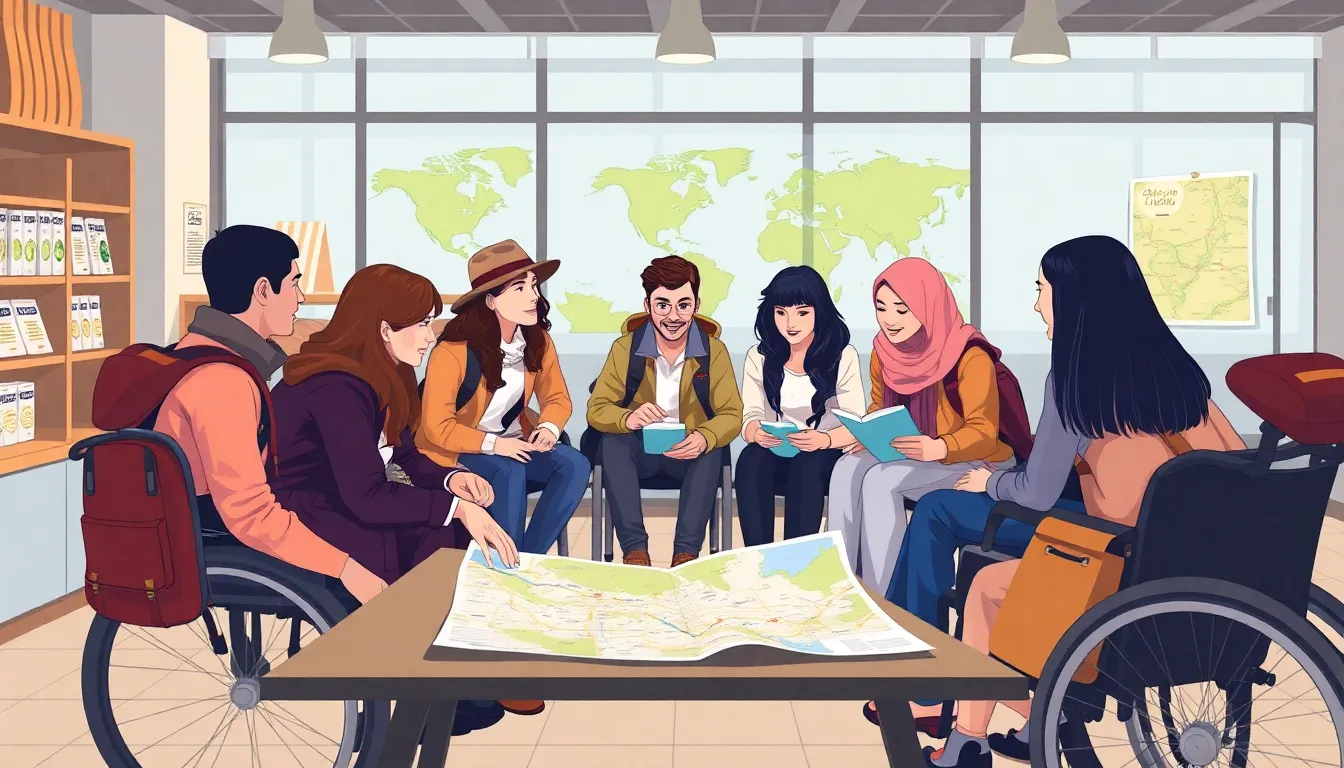Table of Contents
ToggleTraveling should be an adventure for everyone, not a game of obstacle courses. Imagine exploring the world without worrying about whether you’ll be able to navigate a hotel or find a bathroom. Accessible travel isn’t just a trend; it’s a necessity that opens up the globe to all adventurers.
Overview of Accessible Travel
Accessible travel refers to the ability of individuals with disabilities to explore destinations without barriers. Inclusivity defines the experience, ensuring everyone, regardless of mobility or sensory limitations, can participate. This concept extends across various aspects of travel, including transportation, accommodations, and attractions.
Accessibility in transportation involves options like wheelchair-accessible vehicles and trained staff ready to assist. Airports and train stations often provide amenities such as ramps, elevators, and designated seating areas. Destinations with accessible public transport make navigation easier, enhancing the traveler’s experience.
Accommodations play a crucial role in accessible travel. Hotels and lodgings may include features such as roll-in showers, wider doorways, and lowered furniture. Travelers often benefit from websites that specify accessibility options, allowing for informed choices.
Attractions must also prioritize accessibility. Popular tourist sites regularly offer services like guided tours tailored for those with sensory impairments. Interactive exhibits designed for diverse needs promote engagement and enjoyment.
Travel planners and agencies increasingly recognize the necessity of catering to all travelers. They focus on providing resources and information that indicate accessibility features. From itineraries to customer support, attention to detail ensures every traveler feels considered.
Accessible travel supports the ideology that adventure belongs to everyone. Society grows richer through the shared experiences of diverse individuals exploring the world together. With advancements in accessibility, destinations become more inclusive, allowing all travelers to create lasting memories.
Planning Your Accessible Trip

Accessible travel requires thoughtful planning to ensure a seamless experience. Focusing on specific needs while exploring options is key to identifying suitable locations and amenities.
Researching Destinations
Choosing destinations with accessible infrastructure is essential for a smooth trip. Many travelers find online resources valuable for researching attractions with accessibility features. Leveraging user-generated reviews provides firsthand insights into the suitability of locations. Websites such as AccessNow and Wheelchair Travel offer detailed information regarding accessibility at various destinations. Checking local tourism boards helps ascertain compliance with accessibility standards. Filtering options based on personal preferences allows for enhanced travel planning.
Understanding Accessibility Features
Comprehending what accessibility features entail aids in making informed choices. Many accommodations offer features like roll-in showers, grab bars, and wider doorways to enhance comfort. Some attractions provide facilities such as ramps, elevators, and accessible restrooms. Learning about assistive technologies, such as audio guides and captioning services, enriches the experience for diverse needs. Contacting service providers directly can clarify specific features available. Assessing amenities helps travelers select accommodations that meet their requirements effectively.
Transportation Options for Accessible Travel
Accessible travel incorporates various transportation methods that cater to individuals with disabilities. Consideration of flights, airports, and public transit plays a crucial role.
Flights and Airports
Airlines aim to improve accessibility for travelers with disabilities. Most major airlines offer wheelchair assistance at check-in and during boarding. Requests for assistance typically occur at least 48 hours prior to departure to ensure proper arrangements. Seating accommodations often include priority boarding and designated seating options for ease of access. Airports now feature accessible restrooms and seating areas. Travelers can utilize airport assistance services upon arrival to navigate the terminal smoothly. Additionally, many airports provide resources like accessible maps and staff trained to assist.
Public Transit Solutions
Public transit systems increasingly prioritize accessibility features. Buses often come equipped with ramps or low floors for easy boarding. Many metro systems feature elevators and tactile guidance for navigation. Additionally, transit operators usually offer training for their employees to assist passengers with disabilities effectively. Riders can check local transit websites for details on accessibility options. With the rise of rideshare services, accessible vehicle options now cater to a broader range of needs. These services allow for greater flexibility in planning travel routes.
Accommodations for Everyone
Accessible travel accommodations play a crucial role in ensuring comfort for all travelers. Various lodging options now prioritize accessibility features for their guests.
Hotels with Accessibility Options
Hotels increasingly offer amenities that cater to individuals with diverse needs. Roll-in showers, wider doorways, and grab bars are common in accessible rooms. Some chains provide 24-hour assistance, ensuring support whenever required. Booking through platforms that specify accessibility features helps streamline the process. Researching reviews focusing on accessibility can provide insights into guest experiences, enhancing informed choices.
Alternative Lodging Choices
Alternative accommodations also cater to travelers seeking accessibility. Vacation rentals often highlight accessible features, such as step-free entrances and spacious layouts. Many hostels adapt their facilities to welcome everyone, providing inclusive social spaces. Camping sites located near accessible trails accommodate those who enjoy outdoor adventures. Consulting websites that specifically list accessible lodging options can simplify planning, broadening choices for unique stays.
Activities and Attractions
Exploring accessible attractions enhances travel experiences for everyone. It’s essential to select sights and activities that accommodate diverse needs.
Choosing Accessible Attractions
Finding attractions that prioritize accessibility matters for an enjoyable trip. Many cities offer museums and parks with features like ramps, braille signage, and audible guides. Research online reviews focused on accessibility to gauge visitor experiences. Reaching out to attractions beforehand can clarify available amenities and services. Checking for sensory-friendly events, when traveling with individuals on the autism spectrum, can lead to a more comfortable experience. Locating affiliate websites that catalog accessible attractions can streamline planning.
Tours and Experiences
Joining guided tours designed for accessibility offers unique insights and ease of travel. Many operators provide customized experiences with wheelchair-friendly transport and trained staff. Opt for tours that include accessible transportation options, ensuring all participants can enjoy the journey comfortably. Participating in small group tours often allows for a more personalized experience. Adventure activities like scenic drives or boat rides frequently provide adaptations for individuals with mobility challenges. Choose experiences marketed as accessible to ensure inclusivity throughout the itinerary.
Accessible travel is essential for fostering inclusivity and ensuring that everyone can explore the world freely. By prioritizing thoughtful planning and utilizing available resources, travelers can navigate potential obstacles with confidence.
As more destinations and service providers embrace accessibility, the travel experience becomes richer for all. The shared adventures of diverse individuals not only enhance personal journeys but also contribute to a more inclusive society.
With a commitment to accessibility, every traveler can create memorable experiences that reflect the beauty of our diverse world. Embracing this mindset opens doors to new opportunities and adventures for everyone.






